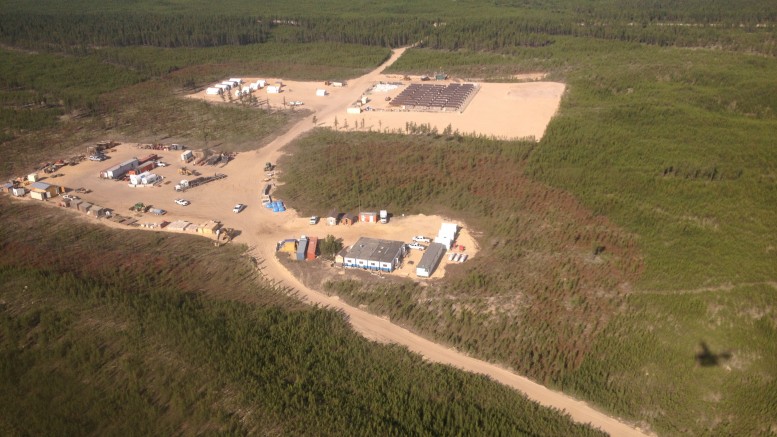VANCOUVER — Fission Uranium’s (TSX: FCU) search for land-based uranium mineralization at its Patterson Lake South (PLS) property in Saskatchewan’s Athabasca basin appears to be boding well for the junior explorer.
The final assay results from the company’s $6.5-million winter drill program confirm high-grade uranium mineralization at its newest discovery, the R1515W zone, which falls on the western edge of the 3.2 km long mineralized trend at PLS.
Out of the eight holes drilled, six were mineralized, with assay results including 8.5 metres of 3.12% U3O8 within a broader interval of 27.5 metres of 1.24% U3O8, and 2.5 metres of 6.03% U3O8 within 12 metres of 3.16% U3O8.

Location map of Fission’s Patterson Lake South uranium project. Credit: Fission Uranium.
A 120-metre step-out hole farther west returned 0.5 metre of 0.74% U3O8, showing that mineralization could extend along geological strike.
While visiting New York on a business trip, Ross McElroy, Fission’s president, chief operating officer and chief geologist, tells The Northern Miner during a phone interview that there’s a “good chance R1515W could blossom into something even better.
“It looks like a whole new area. With more drilling, we hope it can grow into something more meaningful,” he says. “Right now it’s just a few high-grade holes over a 45-metre strike length, but we’re off to a good start. If it’s like the other mineralized zones, it could be anywhere from 200 metres to at least 1 km long.”

A drill rig at Fission Uranium’s Patterson Lake South uranium property in northern Saskatchewan. Credit: Fission Uranium.
Mineralization at PLS occurs along steeply dipping structures, and is often associated with graphitic material, making the zones easy to find using electromagnetic geophysical surveys.
The most advanced zones, R780E and R00E, make up Fission’s Triple R deposit, where resources total 2 million indicated tonnes of 1.8% U3O8 and 785,000 inferred tonnes of 1.6% U3O8. The deposit includes an even higher-grade core of 45.1 million lb. at 18.2% U3O8 as indicated, and 13.9 million lb. at 25.1% U3O8 as inferred, starting at 50 metres below surface.

Fission’s latest drill results have extended the mineralized corridor at its Patterson Lake South property to 3.2 km length. Credit: Fission Uranium.
McElroy says that part of the recent drill campaign targeted the R1620E and R00E zones — found along geological strike of Triple R to the east and west — in preparation for a resource update by year-end.
He’s not sure, however, whether R1515W will be included in the update.
“It’ll take another drill campaign or two to know whether R1515W has a potential resource,” he says. “But I suspect we’ll put another dozen holes into it this year. It’s looking very attractive and it’s something we want to advance.”
McElroy says the upcoming exploration program will focus on the project’s land-based targets. Both Triple R and the R1620E zones occur under a shallow lake.
“We’re trying to develop our land targets, so in a mining scenario we can sequence our land targets with the R780E zone,” he says. “On land, we don’t have to build a dike and slurry wall to keep the water out — we’re just dealing with overburden.”
According to the company’s 2015 preliminary economic assessment, capital expenses for a 14-year operation at Triple R could cost Fission $1.1 billion. The economic analysis shows a 34.2% after-tax internal rate of return and a $1-billion after-tax net present value at a 10% discount rate, assuming a US$65 per lb. U3O8 long-term price.

Uraninite-bearing drill core at Fission Uranium’s Patterson Lake South property in Saskatchewan’s Athabasca Basin runs upwards of 25% U3O8, making it one of the highest-grade uranium deposits in the world. Credit: Lesley Stokes.
McElroy says the company intends to finish a prefeasibility study on the project by late 2018, but in the meantime will explore the R1515W zone and test more parallel-trending structures on the 311 sq. km property.
“Since CGN Mining joined us, we’ve put the first tranche of that money to good work,” he says, referencing the state-owned Chinese company, whose $82.2-million investment in December 2015 earned CGN a 20% stake in Fission.
“We’ve found greenfield targets, developed R840W and R1620E and made them resource ready, and made a discovery. We’re sitting healthy with $50 million in the bank, and that should carry us through another two or three years.”
Despite the drop in spot uranium prices from US$24.50 to US$19.60 per lb. since January, McElroy remains bullish on the commodity.
“Even the low-cost producers have started to reduce their production. If they can’t make money at these prices no one can, and that puts a bottom on the price. What we haven’t seen is the sustained uptick in the market, but we know that’s inevitable. The demand is there — nuclear reactors are being built at a record pace, and there’s more in operation now than ever before. The space looks positive in the long run.”


Be the first to comment on "Fission confirms high-grade uranium discovery at PLS"